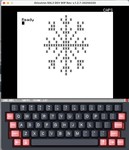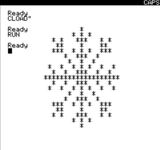Oric

This British computer was one of the most popular computers in Europe in the beginning of the 80's. It was a small computer, which was a competitor of the Sinclair Spectrum.
The two models (16 and 48) had the same technical characteristics.
A small plotter was available for this computer.
Notice that the sound chip was the same one used in the Amstrad CPC, MSX computers and Atari ST!
Its ROM was very buggy, & was later replaced with the Oric Atmos.
The Oric Atmos was the successor of the Oric 1 and had almost the same features. Its main difference with the Oric 1 was the keyboard and the debugged ROM (the ORIC 1 had several bugs). Although improved, the loading process from tape was still very uncertain. The real mechanical keyboard was really better. Two versions were available, with 16 or 48 KB of RAM. 16 KB version couldn't be upgraded, very few of them were sold. There were also new Basic instructions and above all the Scart power supply was integrated on French models from 85! Fantastic, when you know that the Oric had the world record of cables and power supplies you had to use (1 for the computer, 1 for the tape recorder, 1 for the peritel supply and 1 more plug for the TV!). The Atmos had really large success in France like its little brother the Oric-1. A lot of videogame companies got off the ground thanks to this machine, and quite a lot of people have a tender thought when then remember their Atmos. In 1985, Eureka Informatique, a french company, bought back Oric. The Atmos then lived a bit longer thanks to some improvements (peritel power supply and better tape reliability) and cheap prices policy. The Atmos was somehow legally licenced in Yugoslavia as the Nova 64. The Pravetz 8D was a bulgarian clone of the Atmos.
(Note: Description used with courtesy of http://www.old-computers.com)
Recent releases:

|
Kenneth | Dec 2025 | |

|
gliou | Dec 2025 | |

|
DidierV | Dec 2025 | |

|
Iris | Jun 2025 | |

|
Doclands / The Overlanders | Apr 2025 | |

|
Iris | Jun 2024 | |

|
Kenneth | Dec 2023 | |

|
Iris | Jun 2023 | |

|
Mik / Computer Asylum | Dec 2022 | |

|
Mik | Dec 2022 | |

|
Mik | Dec 2022 | |

|
Mik | Dec 2022 | |

|
Dbug | Mar 2021 | |

|
Fabrizio Caruso | Dec 2020 | |

|
Fabrizio Caruso | Jul 2020 | |

|
Triple A | Jun 2019 | |

|
Triple A | Jun 2018 | |

|
Triple A | May 2017 | |

|
Dbug / Defence Force | Jul 2016 | |

|
Fit and Lieves!Tuore | May 2016 | |

|
Defence Force | May 2015 | |
|
|
mmu_man / Triple A | May 2015 | |

|
Defence Force | Feb 2015 | |

|
Defence Force | Nov 2014 | |

|
g0blinish | Nov 2014 | |

|
Defence Force | Jul 2014 | |
|
|
Triple A | May 2014 | |

|
Defence Force | Feb 2014 | |

|
Defence Force | Nov 2013 | |

|
Defence Force | Jul 2013 |